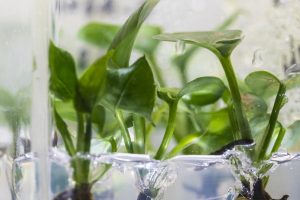
Plant scientists at the Universities of Birmingham and Nottingham have unravelled a mechanism that enables flowering plants to sense and ‘remember’ changes in their environment.
The research, published in the Journal Nature Communications, reveals potential new targets that could support the development of new plant varieties, including cereals and vegetables, that can adapt to different environmental conditions.
Plants’ memory function enables them to accurately coordinate their development in response to stress or to the changing seasons. For example, many plants remember the extended cold of winter, which ensures that they only flower in spring when warmer temperatures return. One way they do this is through a group of proteins called the PRC2. In the cold these proteins come together as a complex and switch the plant into flowering mode. Little is known about how the PRC2 detects environmental change to make sure it is only active when needed.
This new study, which was carried out in collaboration with scientists from the Universities of Oxford and Utrecht, provides new insight into the ‘environment sensing’ function of the PRC2.
Researchers discovered that a core component of the complex – a protein called VRN2 – is extremely unstable. In warmer temperatures and when oxygen is plentiful, VRN2 protein continually breaks down. When environmental conditions become more challenging, for example when a plant is flooded and oxygen is low, VRN2 becomes stable and enhances survival. VRN2 protein also accumulates in the cold. This allows the PRC2 complex to trigger flowering once temperatures rise. The team investigated the reasons for this and found a surprising similarity between plant responses to cold and low oxygen experienced during flooding.
“Plants have a remarkable ability to sense and remember changes in their environment, which allows them to control their life cycle,” explains lead author Dr Daniel Gibbs, from the School of Biosciences at the University of Birmingham. “VRN2 is continually being broken down when it is not needed, but accumulates under the right environmental conditions. In this way, VRN2 directly senses and responds to signals from the environment, and the PRC2 remains inactive until required.”
“It is possible that this mechanism could be targeted to help create plants that are better adapted to different envornmental scenarios, which will be important in the face of climate change.”
Professor Michael Holdsworth, from the University of Nottingham, who co-led the study, said: “It will now be important to investigate how cold leads to increased VRN2 stability and why this response is similar to plant responses to flooding.”
Interestingly, animals also have the PRC2 complex, but do not have an unstable VRN2 protein. “This system appears to have evolved specifically in flowering plants,” added Prof. Holdsworth. “Perhaps it gives them more flexibility in their ability to adapt and respond to environmental change, which is important since they are fixed in the ground and can’t move.”

